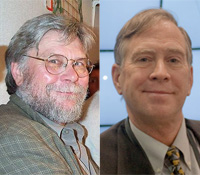Synthesis: Processing and Collaboration |
||
|
||
|
DESCRIPTION/ABSTRACT: Across their careers, Dan Sandin and Tom DeFanti have invented entirely new ways of how mediation operates - extending its ability of recording through processing and into a synthesis of new possibilities. This has taken place through an ongoing process of collaboration where a synthesis of art, engineering and science developed pioneering methods that would influence the creation of the field of new media art. For SYNTHESIS: PROCESSING AND COLLABORATION, Sandin has selected several videos from the 1970s, featuring early image processing and discussions with the collaborators involved. An original Image Processor (IP) and video camera equipment will also be on display in the gallery. Posters from the 1970s performances and events will be on view along the gallery hallway. This exhibition marks the debut of a new Virtual Reality installation for the StarCAVE, PARTICLE DREAMS IN SPHERICAL HARMONICS. Content and application programming: Dan Sandin. Content and systems programming: Robert Kooima. Music and sound effects: Laurie Speigel. Riding Shotgun: Tom DeFanti. The panel discussion offers a unique opportunity to hear from the artists and research collaborators, as well as see Dan Sandin\'s new virtual reality work for 4K, StarCAVE and Alioscopy displays. To RSVP, please email Trish Stone, Gallery Coordinator, at tstone(at)ucsd.edu Media, please contact Doug Ramsey at dramsey(at)ucsd.edu. SPEAKER BIO: Sandin was born in 1942. He received a B.S. in physics from Shimer College, Illinois, and an M.S. in physics from the University of Wisconsin. In 1969, Sandin joined the faculty of the School of Art and Design at the University of Illinois at Chicago. In 1980, he became founder and co-director, with Thomas DeFanti, of an interdisciplinary program between the college of engineering and the school of art and design at the University of Illinois at Chicago. Among his awards are fellowships and grants from the National Endowment for the Arts, the Guggenheim Foundation, and the Rockefeller Foundation. Sandin lives in Chicago. Thomas A. DeFanti, PhD, is a research scientist at the California Institute for Telecommunications and Information Technology (Calit2) at the University of California, San Diego. He is principal investigator of the NSF International Research Network Connections Program TransLight/StarLight project, and he is principal investigator of the NSF GreenLight Instrument project and the KAUST Calit2 OptIPresence Project. DeFanti is an internationally recognized expert in computer graphics since the early 1970s. He has amassed a number of credits, including: use of his lab\'s hardware and software for the computer animation produced for the 1977 \"Star Wars\" movie; recipient of the 1988 ACM Outstanding Contribution Award; and appointed an ACM Fellow in 1994. He also shares recognition along with EVL director Sandin for conceiving the CAVE virtual reality theater in 1991. Striving for more than a decade to connect high-resolution visualization and virtual reality devices over long distances, DeFanti has collaborated with Larry Smarr, Maxine Brown, Joe Mambretti, Tomonori Aoyama, and Kees Neggers to lead state, national and international teams to build the most advanced production-quality networks available to scientists, with major NSF funding. He is a founding member of GLIF, the Global Lambda Integrated Facility, a global group that manages international switched wavelength networks for research and education. In the USA, DeFanti established the 10 Gigabit Ethernet CAVEwave research network between EVL/StarLight, McLean, Virginia, the Seattle/Pacific Northwest GigaPop, and UCSD/Calit2 for CineGrid, OptIPlatform, and other national/international research uses; the CAVEwave is a model for future high-end science and engineering collaboration infrastructure. The new GreenLight Instrument project uses optical networks to connect scientists and their labs to more energy-efficient \'green\' computer processing and storage systems. MORE INFORMATION: |

